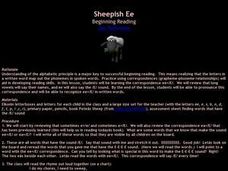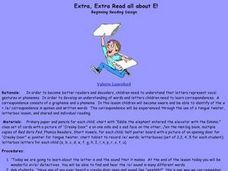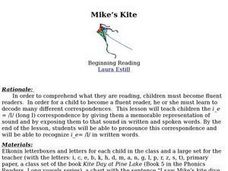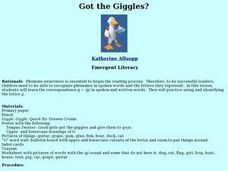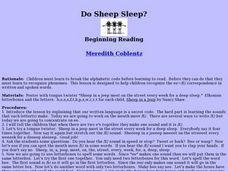Curated OER
Spiders Are Fun
Students study facts about spiders using a number of literary forms, including stories, poems, and songs. They work with consonant sounds by matching pictures with the beginning consonant sounds. They design art projects that emphasize...
Curated OER
Sheepish Ee
Students examine how "ee" makes the /E/ sound using Elkonin boxes and letter manipulatives. While reciting an e rhyme they practice saying the long /e/ sound before reading a story which contains long e words. Finally, they complete a...
Curated OER
Extra, Extra Read all about E!
Learners examine the letter 'e'. Through instruction and modeling they explore the sound the letter makes, how the letter is written, etc. They recite tongue twisters and use letterboxes to write 'e' words. They pick out short /e/ words...
Curated OER
Alphabet
Students state the letters of the alphabet individually and in new words. For this alphabet lesson plan, students use the alphabet in a variety of ways during reading.
Curated OER
Gulping Guppies
Learners recognize the phoneme /g/. Through listening and matching activities, students discriminate the phoneme /g/ from other letters and phonemes. They associate the phoneme /g/ with its letter representation and identify the phoneme...
Curated OER
Aaa! It's a Rat!!
Students answer a series of questions about the different sounds that the letter A makes. They practice saying a tongue twister about the letter A. They write the letter A and attach different words with the letter sounds. They listen...
Curated OER
The Interesting Iguana
Students practice the representation of i=/i/ in correspondence and spoken words. They study spelling and reading words with i=/i/ in letterboxes, circling words in pictures that show words containing /i/, and view a chart with "The...
Curated OER
Mike's Kite
Students explore the long /I/ sound as it is used in 'i_e' words. They recite a long /I/ tongue twister and use letterboxes to practice spelling 'i_e' words. In groups, they read a book with several long /I/ words and identify pictures...
Curated OER
Introduce /ir/
Students recognize and pronounce the /ir/ sound. In this beginning phonics decoding lesson, students say the "ir" sound when the teacher points to the corresponding letters and remain silent when other letter combinations are targeted.
Curated OER
Perfectly Popping
Students identify p in spoken words and the written letter the represents it. The story, Hop on Pop by Dr. Seuss is read the the class. They then have to circle pictures that have the p sound in them. This assessment is done after...
Curated OER
IIII---L-lll-ke---IIII-ke-and-M-IIII-ke
Students recognize the letter combination i_e by reading and spelling words with letter boxes in this instructional activity. They say a tongue twister which emphasizes the long /i/ silent /e/ combination. They then listen the story...
Curated OER
Got the Giggles
Students identify the grapheme and phoneme for G. They practice writing the letter G and through listening activities, discriminate the phoneme /g/. They associate the phoneme /g/ with its letter representation and identify it in various...
Curated OER
Ow! That Hurts
Pupils study the ou=/ow/ correspondence in written and spoken words using a tongue twisters and a letterbox instructional activity. They recite the tongue twister and make given words using the letterboxes. Next, they listen to a read...
Curated OER
Ewww, That's Gross
Students recognize the /ew/ digraph in written and spoken words by reading and spelling words with ew=/oo/. They say a tongue twister emphasizing words with the /ew/ digraph. They then listen to the story "Shoe Man" and identify the...
Curated OER
The Big E!
Students study the correspondence ea=/E/ by examining picture cards that show examples of items with the long "e" sound. They listen to a read aloud of Nancy Shaw's, Sheep Out to Eat before writing words that contain the "ea"...
Curated OER
Do Sheep Sleep?
Students gain insight into the correspondence ee = /EE/ in both written and spoken words. They recite tongue twisters with the /EE/ sound and use letterboxes to spell 'ee' words. They read a book with a variety of /EE/ words.
Curated OER
Let's Go to the Farm
Students explore corresponding letters of the alphabet with the corresponding phonemes using farm animals. They create a classroom word wall of the items they saw on a trip to the farm or zoo. Students create pictures to go along with...
Curated OER
Beginning Reader: Mike Flies Kites
Students review the /i/ sound before studying the i_e=/I/ correspondence. They listen for the /I/ sound in word pairs, make words in letterboxes, and recognize the silent e. Next, working in pairs, they read "Kite Day at Pine Lake." As...
Curated OER
Excellent Elephants
Students study the /e/ by repeating the words "excellent elephants" several times to determine the proper sound. They make words using Elkonin letterboxes before listening to a book talk for the book "Pen Pals." Next, they read the book...
Curated OER
A? Speak up, I can't hear you!
Students become phonemically aware of various sounds that make up written words. This lesson focuses on the vowel correspondence a_e=/A/. They decode the long a mouth moves in words as well as practice spelling the words themselves.
Curated OER
Short 'e'
First graders recognize the short vowel e in written and spoken language. Through matching activities, they discriminate the short vowel /e/ from other phonemes. Students associate the phoneme with its letter representation and identify...
Curated OER
Cranking Cooky Cars
Students practice the strategy of phoneme awareness with special vocal gestures or sound with the correspondence /k/. They listen as the book, "ABC," by Dr. Seuss is read to them and then they work on a tongue twister and worksheets.
Curated OER
Identification of Short Vowels
First graders identify words. In this short vowels lesson, 1st graders identify words that have the short /e/ sound. They work either independently or in a small group to sort picture cards into "yes" or "no" stacks depending on if it...
Curated OER
Achoo!
Focus in on the digraph ch. Young readers will hear the sound, print the letters, and read A Peach for Chad. Can your youngsters think of any more words that use the target sound?



